Structural Concrete Repair
Structural Concrete Crack Repair
Most engineering authorities agree that it is the very nature of concrete structures to crack to a minor or major degree. Cracking indicates that the structure has been forced to absorb the energy of some form of stress. Most engineering authorities agree that it is the very nature of concrete structures to crack to a minor or major degree. Cracking indicates that the structure has been forced to absorb the energy of some form of stress.
Concrete Cracking is caused by:
- Shrinkage During Cure, Before the Concrete has Developed its Full Strength.
- Mechanical Overload, Either Static or Dynamic.
- Temperature Changes in a Structure Where no Provision was Made for Movement or Controlled Cracking.
- Base or Foundation Settlement.
- Overworking or Excess Watering of the Surface.
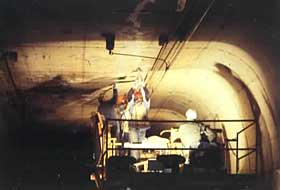
Cracks Can be Repaired
However, when a concrete structure has cracked for any of those basic reasons, it does not necessarily mean that the structure has failed. On the contrary, any cracked concrete structure can be repaired effectively and most often permanently, provided the structure has not been wholly deformed and the original cause of cracking has stopped.
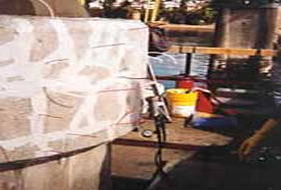
bridge abutment repair using ChemCo epoxy injection
KIP—Kemko® Injection Process
This is a proprietary method of epoxy injection fissures down to 0.002 inches wide for their full depth with a high strength epoxy resin adhesive. All of the speciality contractors practicing this method have been trained at ChemCo Systems. When the injected adhesive cures, it seals the crack entirely and also restores the concrete to its original monolithic condition. Injecting repairable cracks in concrete will:
- Restore Structural and/or Design Strength to the Cracked Concrete Structure.
- Eliminate Serious Spalling of Concrete Initiated By Cracking and Aggravated By Freeze Thaw Cycling.
- Prevent Corrosion of Reinforcing Steel and Pre-Stress Tendons By Encapsulating Them Against Moisture or Water Contact.
- Stop the Leakage of Water and Fluids Through Concrete Structures.
- Repair Concrete Achitecturally Without Any of the Unsightly Surface Marks Caused By Standard Surface Crack Repairs.
How Crack Injection Works

A temporary seal is applied to the crack face and entry ports are placed in the seal along the crack plane. If the crack extends entirely through the concrete, the back side is also sealed to prevent adhesive run out.
Two electronically controlled coupled metering pumps drive the two components (resin and hardener) of a fast-setting epoxy adhesive to a special mixing head. The adhesive is mixed at the nozzle and injected through a special gasket that prevents leakage on the face of the concrete.
The adhesive is pumped into the first entry port until it begins to show at the next adjacent port. The operator knows that the adhesive has reached the full depth of the concrete member when the adhesive oozes out of the next port.
The first injected port is then plugged and injection is resumed at the second port. This procedure is followed until the entire crack or void in the concrete is filled. The procedure is similar on horizontal or vertical surfaces. On vertical members the first port injected is usually the lowest and injection progresses upward. Injection pressures range from 2 p.s.i. to 300 p.s.i. and are controlled by the operator.
After the epoxy adhesive has cured, the temporary surface seal is removed, leaving the face of the concrete smooth and unmarred except for the faint trace outline of the crack. Sacking or painting usually will hide the injected cracks completely. We offer a simplified pictorial version of these epoxy injection crack repair procedures on youtube.
ChemCo Systems offers the KIP system on a contractual service basis through KIP licensed applicators throughout the U.S., Canada and several international locations. This extensive network of licensees ensures a quality project each time. Each approved KIP applicator has undergone hands-on technical training conducted by ChemCo Systems.
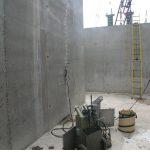
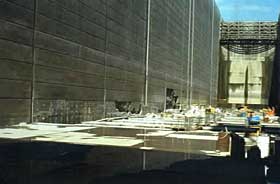
For Earthquake Damage to Concrete Using Epoxies
Nothing more typifies the maximum effectiveness of the KIP system than the role it has played in restoring concrete structures damaged by earthquakes. Without the high strength, economical repairs made possible only by epoxy injection, scores of buildings in the U.S., Asia, Europe, Middle East and Central America would have been scrapped and rebuilt.
Underwater Concrete Repair Using Underwater Epoxies
In 1976, our technical staff began developing an injection system that could be effectively employed for the repair of submerged concrete structures. After several years of product engineering and field evaluation, this development has greatly increased the scope of the KIP System, making it even more versatile and effective for restoring concrete structures in a variety of service demands throughout the world. Offering the highest quality concrete crack repair injection low viscosity epoxy adhesives (and pastes or gels) for over 60 years.
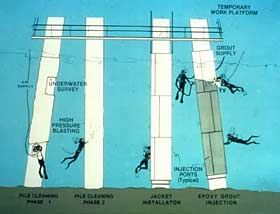
Tell us about your project
CALL 650-261-3790.

